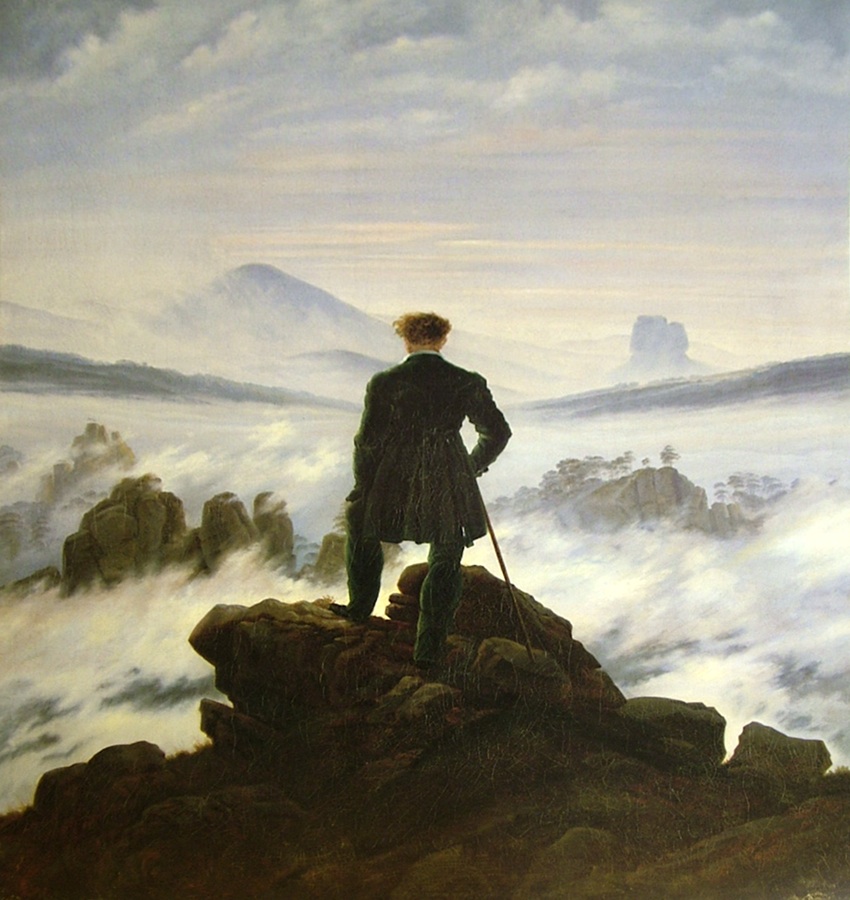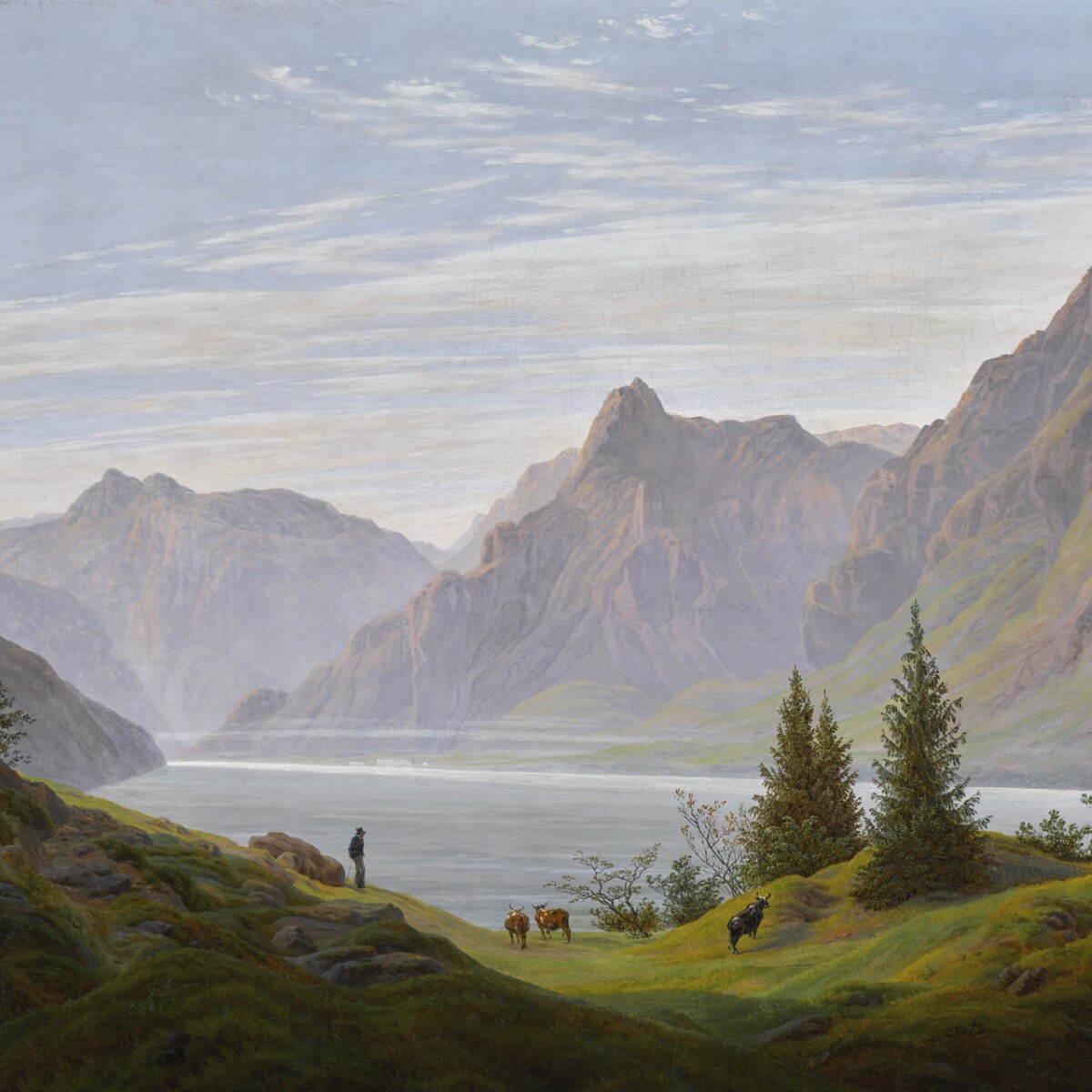
The Traveller by Casper David Friedrich
Caspar David Friedrich's paintings boldly presented the observer with the sublime in order to convey a sensation of the limitless. Caspar David Friedrich's artworks imbued the usually minor genre of landscape painting with profound theological and spiritual meaning. He used sunlit vistas and foggy plains to portray the divine's.

The Contemplative Landscapes of German Romantic Painter Caspar David Friedrich
Caspar David Friedrich's On the Sailing Boat features the bow of a ship heading towards the horizon. Two figures, a man in a blue suit and hat and a woman in a pink dress with white lace collar, hold hands while looking at what lays ahead. The right side of the canvas is consumed by a closely focused depiction of the sail and the boat's mast.

21 Facts about Caspar David Friedrich 19th Century European Paintings Sotheby’s
The German painter Caspar David Friedrich was one of the most prominent artists of the early 19th century Romanticist movement. Dealing with themes such as natural power, human curiosity and mortality, and spirituality, Friedrich's work is at once both macabre and stunningly alluring. Here are five highlights that you should get acquainted with.

FileCaspar David Friedrich 013.jpg Wikipedia
Caspar David Friedrich. As a German Romantic painter, Caspar David Friedrich was a great contributor to the art world. He had a tough childhood never fully recovering from the deaths of his mother and siblings in his early life. This tragedy transferred over into his art, connecting Friedrich to God, nature and God in nature.

Caspar David Friedrich's Vision of the Sublime 19th Century European Paintings Sotheby’s
Caspar David Friedrich was born the sixth of ten children in Greifswald, Swedish Pomerania, on the Baltic Sea. He grew up under the strict Lutheran creed of his father Adolf Gottlieb, a prosperous candle-maker and soap boiler. Friedrich had an early familiarity with death: his mother, Sophie Dorothea Bechly, died in 1781 when Caspar David was just seven.

Caspar David Friedrich Two Men Contemplating the Moon, 182530 Tutt'Art Pittura
Caspar David Friedrich. Caspar David Friedrich (5 September 1774 - 7 May 1840) was a 19th-century German Romantic landscape painter, generally considered the most important German artist of his generation. He is best known for his mid-period allegorical landscapes which typically feature contemplative figures silhouetted against night skies.

ART & ARTISTS Caspar David Friedrich part 2
Caspar David Friedrich was an exemplary figure of German Romanticism known for his paintings of landscapes and Gothic architecture.Friedrich employed subjects such as passing ships, isolated figures, and glowing light as esoteric symbols of mortality, as seen in his paintings Wanderer above the Sea of Fog (1818) and The Stages of Life (1835)."All authentic art is conceived at a sacred moment.

Caspar David Friedrich "Felsenschlucht", um 1822/23 Caspar david friedrich, Landscape
1. The Cross in the Mountains. Caspar David Friedrich, The Cross in the Mountains, 1808, Gemäldegalerie Alte Meister, Dresden, Germany. This was one of Caspar David Friedrich's earliest and most controversial paintings. He made the frame himself, and it is an important part of the masterpiece.
Mistrzowie Malarstwa Caspar David Friedrich
Caspar David Friedrich, one of the leading figures of the German Romantic movement. His vast, mysterious, atmospheric landscapes and seascapes proclaimed human helplessness against the forces of nature and did much to establish the idea of the Sublime as a central concern of Romanticism. Friedrich

Romanticism in the Visual Arts Caspar David Friedrich The Pictured World Within
Caspar David Friedrich was born in Greifswald, a small town on the Baltic Sea. After studying at the Copenhagen Art Academy, in 1798 he settled in Dresden, then a center of the German Romantic movement
.jpg)
Portrait of Caspar David Friedrich by Caspar David Friedrich
Caspar David Friedrich was a 19th-century German Romantic landscape painter, generally considered the most important German artist of his generation. He is best known for his mid-period allegorical landscapes, which typically feature contemplative figures silhouetted against night skies, morning mists, barren trees or Gothic ruins..

Caspar David Friedrich Riesengebirge (1835)
Before he took up painting in 1807, Caspar David Friedrich had already created some of the most fascinating landscape drawings of his time. This exceptionally large sheet from about 1805-6 is based on sketches made on the island of Rügen, in the Baltic Sea, not far from the artist's birthplace.

Friedrich Caspar David Caspar david friedrich, Caspar david friedrich paintings, Romanticism
The Berlin exhibition, Caspar David Friedrich: Infinite Landscapes, will examine the Nationalgalerie's role in rediscovering the artist at the beginning of the 20th century.During his lifetime.
.jpg)
W głąb obrazu Caspar David Friedrich Człowiek wobec potęgi gór
Caspar David Friedrich. Caspar David Friedrich (September 5, 1774 - May 7, 1840) was a landscape painter of the nineteenth-century German Romantic movement, of which he is now considered the most important painter. A painter and draughtsman, Friedrich is best known for his later allegorical landscapes, which feature contemplative figures.

Caspar David Friedrich Werke, Bilder und Gemälde) Mondaufgang am meer, Alte nationalgalerie
Caspar David Friedrich (1774-1840) reimagined European landscape painting by portraying nature as a setting for profound spiritual and emotional encounters. Working in the vanguard of the German Romantic movement, which championed a radical new understanding of the bond between nature and the inner self, Friedrich developed pictorial subjects.

The Contemplative Landscapes of German Romantic Painter Caspar David Friedrich
Caspar David Friedrich (5 September 1774 - 7 May 1840) was a German Romantic landscape painter, generally considered the most important German artist of his generation. He is best known for his allegorical landscapes, which typically feature contemplative figures silhouetted against night skies, morning mists, barren trees or Gothic ruins.